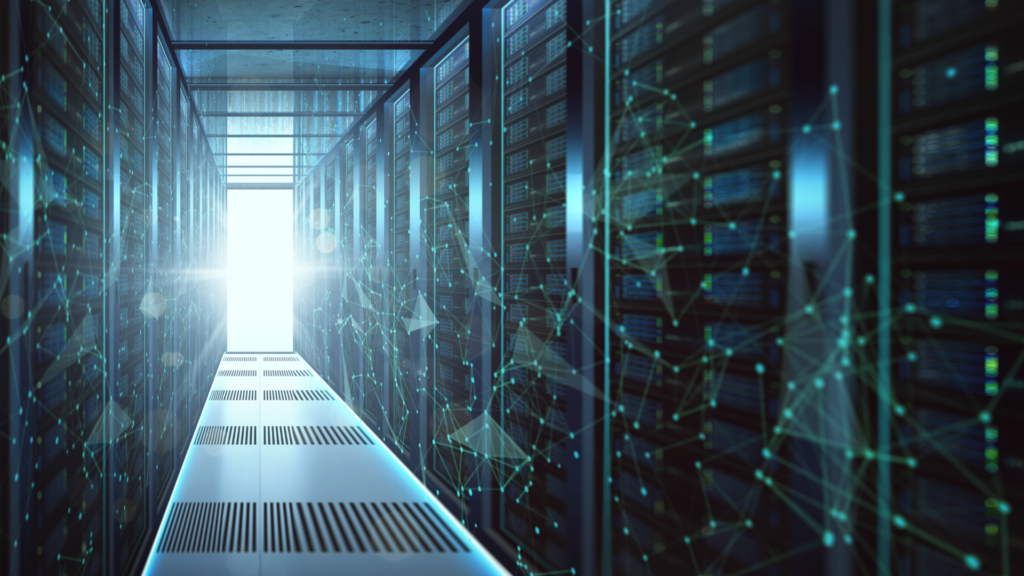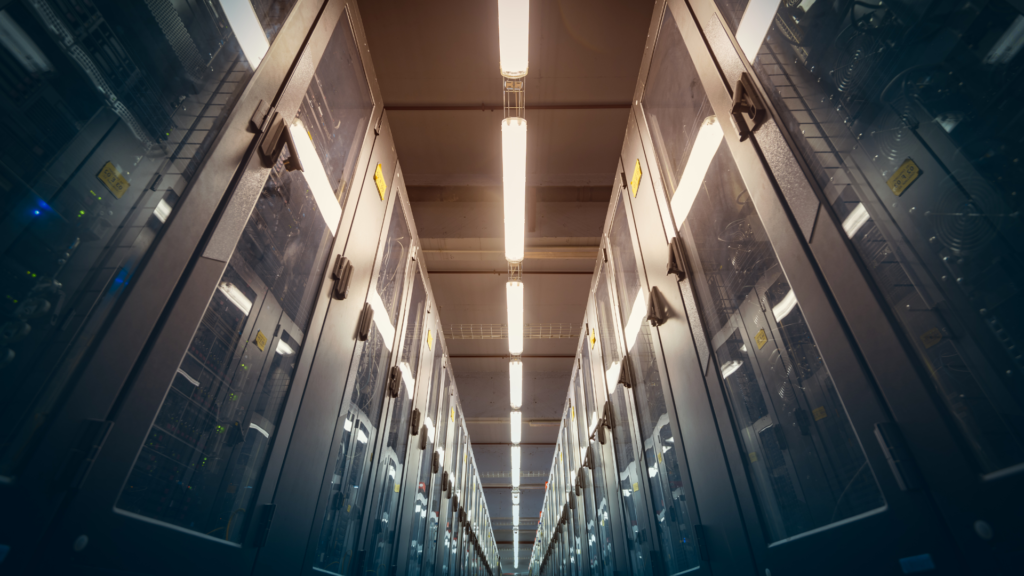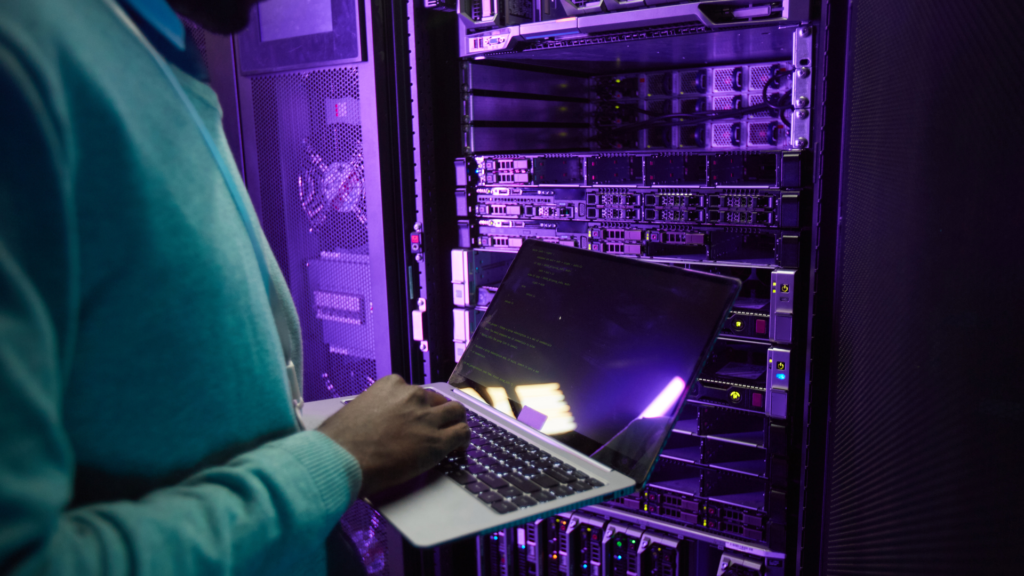
Table of Contents
AI’s Influence on the Data Center Colocation Market
As Artificial Intelligence (AI) technologies continue to proliferate, they bring a series of challenges and opportunities for the data center colocation market. AI demands significant changes in data center design, unprecedented levels of power, improved power and cooling efficiency, and other factors. This article explores the demands of AI colocation, including:
- The current data center landscape and AI’s impact.
- The impact of artificial intelligence on data center power consumption.
- The shift to edge computing driven by AI demand.
- How AI is affecting secondary and tertiary data center markets.
- The impact of the AI market on colocation pricing and other critical cost factors.
- How Brightlio can help with your AI colocation needs.
Let’s get started!
The Data Center Landscape in the World of AI
According to Data Bridge Market Research, spending in the AI infrastructure market is expected to hit $422.5 billion by 2029. This represents a remarkable combined annual growth rate of 44% over the next six years.
Nvidia’s CEO, Jensen Huang, estimates a much higher data center expenditure driven by generative AI. Huang predicted that over the next four years, $1 trillion will be spent upgrading data centers. Hyperscalers like Amazon, Google, Microsoft, and Meta will absorb most of these costs. Much of this will be spent on data centers and hardware like GPUs.
International Data Corp. estimates that about 20% of total data center capacity is already used for AI. Cushman & Wakefield estimates that AI will drive $75 billion in data center demand by 2028, representing 35% of the total market. Data center capacity was at a premium before the rise of AI, especially in Tier 1 markets like Los Angeles, Phoenix, New York, Ashburn, Silicon Valley, and Singapore. CBRE’s 2023 data center trends report states that data center vacancy is at a decade-low across all major North American markets. Europe, Asia, and Latin America are also seeing strong demand. Experts expect supply constraints to ease by 2025 in some markets and only by 2029 in others.

The Impact of AI on Data Center Power
As AI applications become more specialized, so does the hardware that powers them. We’re seeing the advent of customized AI processors and servers optimized for tasks like machine learning, natural language processing, and data analytics. These AI-specific chips, such as TPUs, require more power-dense racks to operate optimally.
High-performance chips and specialized servers for artificial intelligence require increasing the traditional 5-7 kW of power per data center rack. The next wave of GPU nodes uses as much as 10 kW per unit. 50 kW to 100 kW racks are being built for AI workloads. Digital Realty, a global data center leader, announced high-density colocation services in 28 North American markets with support for up to 70 kW per rack.
Higher power densities require more advanced cooling systems. Traditional data center air cooling technologies work up to about 20 kW per rack. The high power density racks AI needs require liquid cooling. This is an expensive retrofit for data center providers.
As energy costs are one data centers’ biggest expenses, power efficiency has a pivotal role in the future of data center design. Data center operators must design more efficient power and cooling equipment to support generative AI.
The Demand for Data Center Sustainability
As power requirements surge, the spotlight turns to energy-efficient operations. Data centers already consume as much as 4% of global energy. Colocation providers must supply sufficient power and do so in a way that aligns with growing sustainability concerns.
The good news is that AI data centers can leverage this technology to increase efficiency. Gartner states that by 2025, 50% of data centers will employ robotics with AI and machine learning capabilities. Using AI and machine learning in data centers will likely improve operating efficiency by 30%.

Rise of Edge Computing due to AI
Edge computing is not new, but AI has accelerated its importance. AI algorithms often require rapid data processing near the source to reduce latency, especially in applications like autonomous vehicles, IoT devices, and real-time analytics. Running AI models close to the data source allows instantaneous data processing, which is crucial for applications requiring real-time decision-making.
Transmitting data to a centralized data center involves latency. Edge computing dramatically reduces this latency by decentralizing the data processing tasks.
Delivering AI to the edge requires data center and cloud deployments in more markets. Additionally, supply constraints in primary markets mean AI providers are overflowing into secondary and tertiary markets to meet demand. Salt Lake City, Austin, San Antonio, and Reno are all seeing increasing demand.
The Impact of AI on Data Center Colocation Pricing
AI is driving up data center pricing and the cost of colocation services. Data center demand is at an all-time high. This is having a noticeable impact on price.
Additionally, operators have to pass along higher operational expenses and costs to retrofit facilities for the demands of AI. These include costs related to state-of-the-art equipment, increased energy consumption due to high-powered AI workloads, and the hiring of skilled personnel well-versed in AI operations.
Strategic data center hubs are showing rising costs. In Northern Virginia, the world’s largest data center market, prices increased 7.7% to $140 per kilowatt in 2023. In Silicon Valley, where data center vacancy sits at a record low of 2.9%, the highest rates have reached $250 per kilowatt in 2023. This is an increase of 43% from 2022. This underscores the desperate scramble among tech giants and emerging companies to secure space in a region synonymous with cutting-edge technological advancements.

Conclusion
The impact of AI on the colocation market is transformative and far-reaching, altering everything from hardware specifications to market dynamics. As AI proliferates, it’s reshaping how data centers operate and where they need to be. Colocation providers need to swiftly adapt to these changes to capitalize on emerging business opportunities and satisfy changing client demands. Customers should also brace themselves for higher data center service prices.
Brightlio Delivers AI Colocation Solutions
If you are looking for colocation services, Brightlio can help. Whether you are looking for a dense power footprint for AI applications or a more traditional data center design, we leverage our global network of colocation partners to deliver solutions that meet your needs and budget.
Additionally, we offer network connectivity, cloud, unified communications, and advisory services. This allows us to deliver a holistic technology solution for your enterprise. We are committed to being your most trusted and responsive technology provider.
Get started with Brightlio today!

FAQ: AI’s Influence on the Data Center Colocation Market
What is the influence of artificial intelligence on data centers?
Artificial intelligence (AI) is driving significant changes in the data center industry, requiring enhanced infrastructure to accommodate increased power demand, advanced cooling systems, and optimized AI workloads. I
Why are data center operators paying more attention to AI?
Data center operators recognize the growing demand for AI applications, which require immense computing power and can have profound impacts on power consumption and data center infrastructure.
How do AI workloads differ from traditional data center workloads?
AI workloads, especially those related to machine learning and deep learning, require more compute and speed. They often demand higher power usage, advanced cooling systems, and specialized infrastructure compared to traditional workloads.
Is the increased power demand for AI impacting data center costs?
Yes, the increased power demand for AI can raise data center costs. This encompasses not only direct power costs but also costs associated with cooling and infrastructure modifications to support AI’s power-intensive tasks.
What role does cloud computing play in the integration of AI into data centers?
Cloud computing platforms, due to their scalable nature, are often at the forefront of integrating AI capabilities. They provide companies with the ability to leverage AI without heavy upfront investments in their own data center infrastructure.
Why is cooling a crucial aspect when addressing AI’s needs in data centers?
AI workloads, particularly those on specialized hardware like GPUs, produce significant heat. The increased power consumption requires more advanced cooling systems to maintain optimal temperatures and protect systems.
Recent Posts
Vancouver Data Centers: Colocation in the Pacific Northwest
Business Broadband Solutions: The Ultimate Guide
Let's start
a new project together



